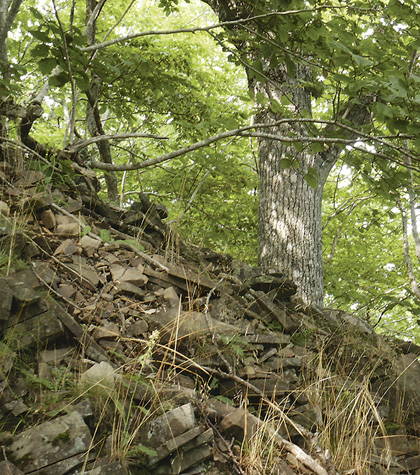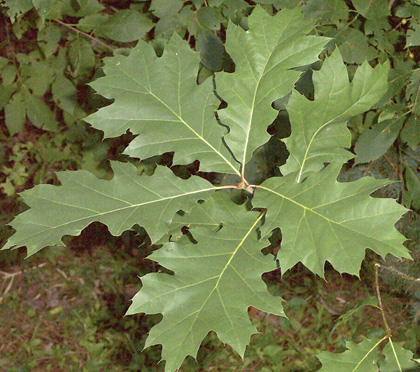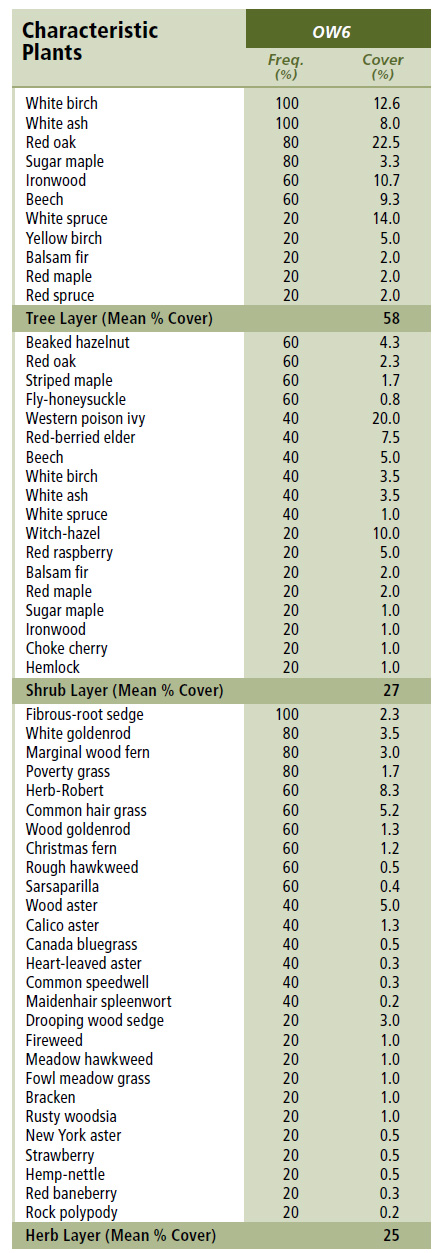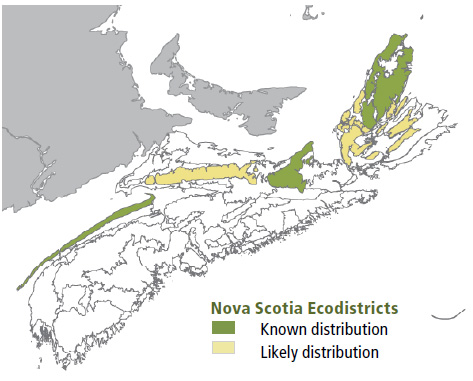
Forest Vegetation types - OW6
OW6 — White birch – Red oak – White ash / Marginal wood fern– Herb-Robert
Betula papyrifera – Quercus rubra – Fraxinus americana /Dryopteris marginalis – Geranium robertianum
 |
North Mountain, Kings County |
Concept: The White birch - Red oak - White ash / Marginal wood fern - Herb-Robert woodland is found on stony colluvium deposits and relatively stable talus slopes. OW6 is similar to OW3 (Red spruce / Red-berried elder / Rock polypody), but is generally associated with richer site conditions. OW6 is a rare woodland Vegetation Type (VT) found only in areas where steep topography and nearby mafic bedrock outcropping has led to rich stony colluvium and talus deposits. Deciduous woodlands on more acidic deposits have not been surveyed.
Vegetation: Canopy composition is somewhat variable but usually includes white birch, red oak and/or white ash; any of these tree species may dominate. A less common variant of OW6 is characterized by high ironwood cover. Understory associates may include plants tolerant of disturbance (e.g. red raspberry, white goldenrod and poverty grass), droughty substrates (e.g. marginal wood fern, fibrous root sedge, hair-bell and hay-scented fern) and/or nutrient enrichment (e.g. herb-Robert , Solomon's seal and maidenhair spleenwort.
Environmental Setting: The ecosystem is supported by soils associated with stony colluvium or embedded in crevices among talus rock fragments. These fragments of broken and weathered rock are found on side slopes and bases and are usually angular and cobble to boulder sized. Woodland vegetation can sometimes grow on islands of stable talus found within a larger area of more active deposition. The ecosystem is found at moderate elevations on steeper slopes, particularly in areas with more rugged topography. Most stands are in the North Mountain ecodistrict, but outliers occur in parts of Cape Breton. This Vegetation Type is also scattered across New Brunswick.
Successional Dynamics: An early to mid-successional stage is described, but successional development is strongly limited by site constraints. On more stable talus, gaps between rock fragments may become in-filled with deeper mineral soil and humus providing a better medium for the development of upland tolerant hardwood forest. This could be marked by a full Vegetation Type change as site conditions improve.
Ecological Features: Hardwood talus woodlands are an uncommon small patch ecosystem that are both undersampled and poorly understood in Nova Scotia. Plots were established on nutrient rich talus, but OW6 has been observed on more acidic substrates. Acidic (low nutrient) sites do not support white ash or ironwood, and have higher relative levels of beech, yellow birch and red maple. Similarly, stands from cooler areas are less likely to feature red oak or white ash. White birch – Red oak – White ash / Marginal wood fern – Herb-Robert woodland supports particularly unique habitat conditions, but most associated animal, plant and lichen species are undocumented. Some exceptions include the rock vole, Gaspé and long tailed shrews, various land snails, shepherdia and anise-root. Canopy closure is variable but stand structures tend to be complex, supporting diverse microhabitats.
 |
| Red oak |
Distinguishing Features: This hardwood woodland of white birch, red oak and ironwood occurs on talus slopes. White goldenrod, marginal wood fern and herb-Robert are strong indicators.
| Slope Position: | Middle4 Upper4 Lower2 |
Surface Stoniness: |
nd10 |
Bedrock Outcrop: |
nd10 |
Elevation Range: |
61 - 200m |
Slope Gradient: |
Moderate8 Gentle2 |
Aspect: |
East2 South8 |
Exposure: |
nd10 |
Microtopography: |
nd10 |
Drainage: |
nd10 |
Soil Type: |
nd10 |
Parent Material: |
Colluvium10 |
Rooting Depth (cm): |
nd10 |
Duff Thickness (cm): |
nd10 |

